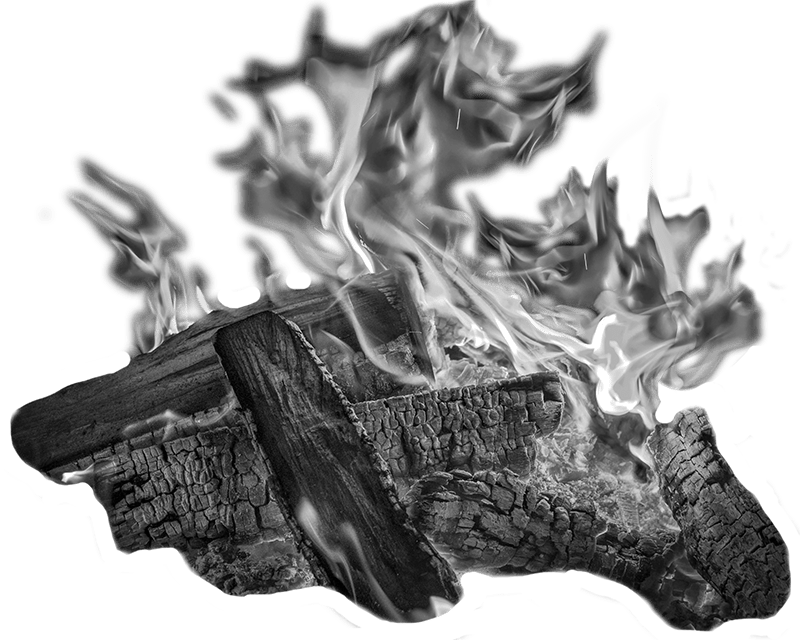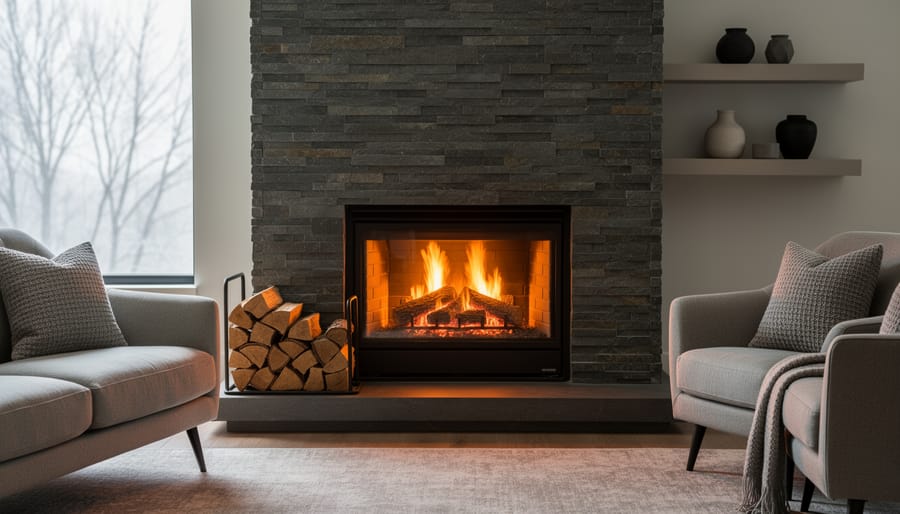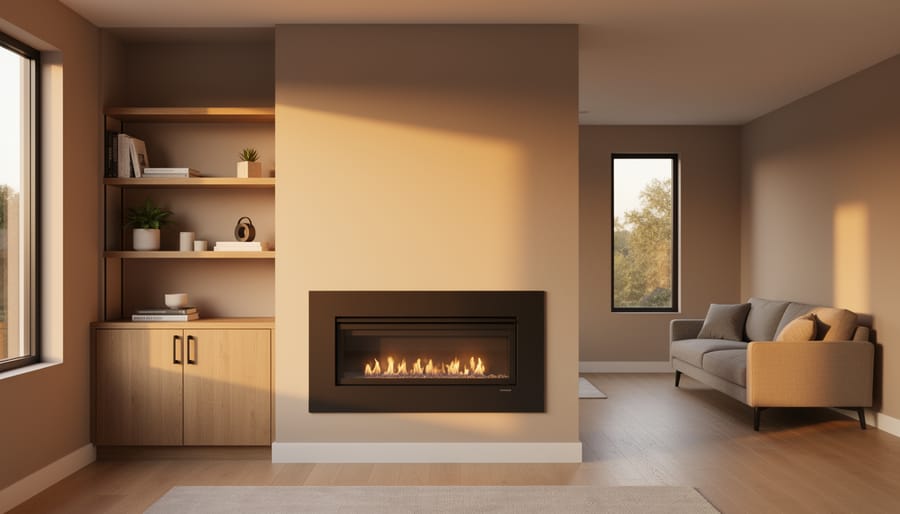The crackle of a wood fire brings undeniable comfort, but not all fuel sources are created equal when it comes to environmental impact. Burning recycled or reclaimed wood might seem like the ultimate eco-friendly solution—giving old materials new purpose while heating your home. However, this seemingly green choice hides serious risks that could compromise both your health and your fireplace’s integrity.
Treated lumber, painted wood, and construction debris often contain toxic chemicals like arsenic, lead, and formaldehyde that release dangerous fumes when burned. These invisible pollutants don’t just disappear up your chimney—they contaminate indoor air quality and contribute to outdoor pollution. Meanwhile, creosote buildup from improper fuel accelerates dramatically, creating fire hazards that threaten your home’s safety.
The good news? You can achieve truly sustainable heating without compromise. Understanding which recycled woods are safe, recognizing warning signs of treated materials, and exploring modern eco-friendly alternatives empowers you to make informed decisions. This guide cuts through the confusion, revealing how to enjoy guilt-free fires that protect both your family and the planet—because environmental responsibility should never come at the cost of safety or warmth.
The Promise and Peril of Recycled Wood as Fuel
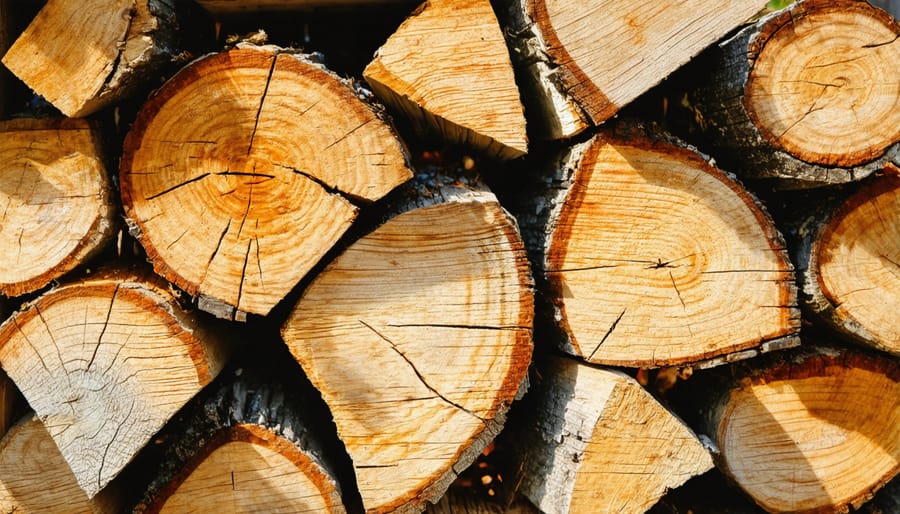
What Counts as Recycled Wood?
Recycled wood comes from various sources, each with distinct characteristics that affect its safety for burning. Understanding these differences helps you make informed choices for your eco-friendly fireplace.
**Reclaimed lumber** from old barns, buildings, or demolished structures represents the most common type. This wood often features beautiful aged patinas and dense grain patterns from slow-growth trees. However, it may harbor hidden nails, screws, or chemical treatments that make it unsuitable for burning.
**Salvaged pallets** are readily available and tempting for firewood, but approach them cautiously. Many pallets undergo chemical treatments to prevent pest infestation during shipping, marked by stamps like “MB” (methyl bromide treated). Only pallets stamped “HT” (heat treated) are potentially safe alternatives.
**Construction waste** includes offcuts, dimensional lumber, and framing materials. While this seems like practical recycling, construction wood frequently contains glues, resins, pressure treatments, or paint that release toxic fumes when burned.
**Furniture pieces** might appear harmless, but older furniture often contains lead-based finishes, while newer pieces use particleboard with formaldehyde-based adhesives—both dangerous when combusted.
The golden rule? When uncertain about recycled wood’s history or treatment, it’s better left unburned in your environmentally conscious home.
The Environmental Case for Recycling Wood
Choosing recycled wood for your fireplace can be a meaningful part of your sustainable heating strategy, but it requires careful selection. When you burn untreated, unpainted wood that’s been salvaged from construction projects or fallen trees, you’re giving new life to materials that would otherwise take up valuable landfill space. This reduces methane emissions from decomposing wood in dumps and decreases demand for freshly harvested timber.
The carbon footprint benefits are real when done right. Wood is considered carbon-neutral since it releases only the carbon dioxide it absorbed during growth. By rescuing quality wood destined for disposal, you’re maximizing its lifecycle without contributing to deforestation.
However, the environmental advantages only hold true with proper wood selection. Untreated hardwoods like oak, maple, or cherry work beautifully, offering efficient heat while minimizing environmental impact. The key is ensuring your recycled wood is free from chemicals, paints, or treatments that could release harmful toxins. Think of it as giving discarded materials a second chance to warm your home while treading lightly on our planet.
The Hidden Dangers Lurking in Recycled Wood
Toxic Chemicals and Treated Wood
When you’re creating a cozy, eco-friendly atmosphere in your home, understanding what not to burn is just as important as choosing the right fuel. Pressure-treated lumber, commonly used for decks and outdoor structures, contains chemicals like chromated copper arsenate (CCA), alkaline copper quaternary (ACQ), or other preservatives designed to prevent rot and insect damage. While these treatments extend the wood’s outdoor life, they create serious health hazards when burned.
The same caution applies to painted wood, varnished furniture, and any wood with a glossy finish. These materials contain heavy metals, volatile organic compounds (VOCs), and synthetic resins that release toxic fumes when combusted. What seems like a practical way to dispose of old furniture or leftover construction materials actually transforms your fireplace into a source of dangerous air pollution.
When these treated materials burn, they release arsenic, lead, cadmium, and other harmful chemicals into your home’s air. These toxins don’t just disappear up the chimney—they linger in indoor air, settle on surfaces, and can accumulate in your body over time. The ash residue also becomes hazardous waste, unsafe for garden use or normal disposal.
Even if the wood looks perfectly normal from the outside, treated lumber often has a greenish or brownish tint and may appear cleaner than naturally weathered wood. If you’re unsure about a piece of wood’s history, it’s always safer to skip it and stick with clean, untreated firewood for a truly environmentally responsible fire.
How Contaminated Wood Damages Your Fireplace
Burning contaminated or treated wood in your fireplace doesn’t just compromise air quality—it can seriously damage your heating system and your wallet. When you burn painted, stained, or pressure-treated wood, the chemicals create an aggressive form of creosote that builds up much faster than normal. This sticky, tar-like substance clings stubbornly to your chimney walls, dramatically increasing fire risk and requiring more frequent professional cleanings.
The metal components in your fireplace and chimney face another threat: corrosion. Treated wood releases chlorides and other corrosive compounds that eat away at dampers, flue liners, and chimney caps. What might have lasted decades can deteriorate in just a few years, leading to costly repairs or replacements.
Your fireplace’s efficiency takes a hit too. Contaminated wood often contains higher moisture content and burns at lower temperatures, producing less heat for your home while generating more smoke and particulates. You’re essentially getting less warmth while causing more damage—the opposite of what an eco-friendly heating solution should deliver. Protecting your fireplace means being selective about what you burn, ensuring both safety and long-term performance.
Health Risks to Your Family
Your family’s health should always be your top priority when creating that cozy fireside ambiance we all love. While an environmentally friendly fireplace can be a wonderful addition to your home, burning the wrong type of wood can turn your living space into a source of harmful pollutants.
When treated, painted, or chemically contaminated wood burns, it releases toxic fumes directly into your home’s air. These aren’t just unpleasant odors—they’re genuinely dangerous compounds that your family breathes in. Pressure-treated lumber, for instance, can emit arsenic and chromium, while painted wood releases volatile organic compounds (VOCs) that irritate respiratory systems and can cause long-term health issues.
Children, elderly family members, and anyone with asthma or allergies are especially vulnerable to poor indoor air quality. Even if you can’t see or smell anything unusual, these invisible toxins accumulate in your home, potentially causing headaches, dizziness, and respiratory problems. The good news? These risks are completely avoidable by choosing clean, untreated wood and following proper burning practices for your eco-friendly heating solution.
How to Identify Safe Recycled Wood for Your Fireplace
The Green Tint Test and Other Visual Clues
Before you toss that scrap lumber into your fireplace, let’s talk about spotting the troublemakers. Pressure-treated wood, commonly used for decks and outdoor structures, contains chemicals that release toxic fumes when burned—definitely not what you want circulating in your cozy living space.
The easiest way to identify pressure-treated wood is the green tint test. Look for a distinctive greenish or yellowish hue that often appears throughout the wood grain. While newer treatments may be less obvious, that telltale green is your first warning sign. You’ll also notice small incision marks or stamps on the wood indicating its treatment type—CCA, ACQ, or similar codes are red flags.
Other visual clues include an unusually uniform color, a chemical odor when cut, or tags and labels mentioning preservatives. Plywood, particleboard, and any wood with paint, stain, or varnish should also stay out of your fireplace. These materials release harmful chemicals and don’t burn efficiently, undermining your eco-friendly heating goals. When in doubt, stick with natural, untreated wood from known sources—your lungs and the environment will thank you.
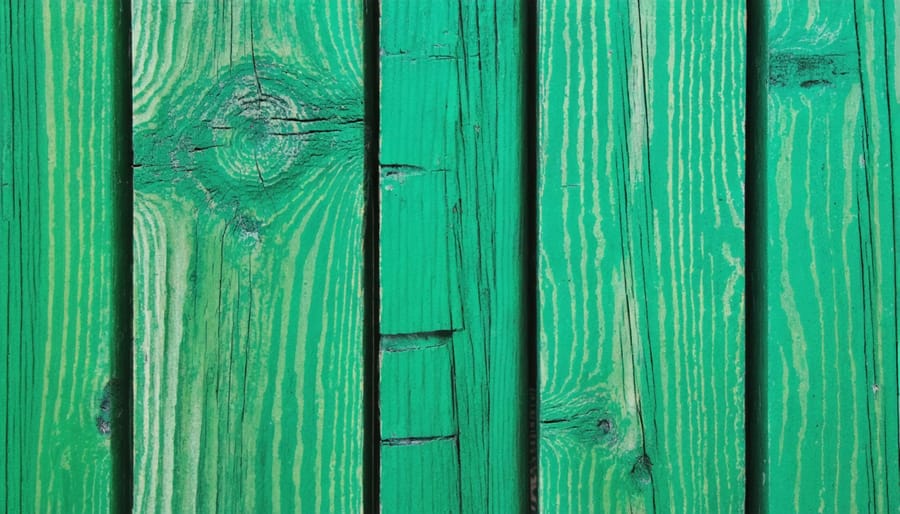
Safe Sources of Recycled Wood
When you’re committed to eco-friendly heating, finding safe recycled wood sources can help you reduce waste while keeping your home cozy. The key is knowing where to look and what to accept.
**Heat-treated pallets** marked with “HT” stamps are your safest bet in the recycled wood category. These have been kiln-dried rather than chemically treated, making them burn-friendly. Just steer clear of any pallets stamped with “MB” (methyl bromide) or those showing stains, odors, or unknown origins.
**Clean construction scraps** from new building projects can be excellent firewood—think offcuts of dimensional lumber, untreated 2x4s, and natural trim pieces. Connect with local builders or check construction sites (with permission, of course) for these hidden gems. Just ensure they’re free from paint, varnish, glue, or pressure treatment.
**Natural wood furniture** that’s reached the end of its life—like solid wood chairs, tables, or bed frames—can find new purpose in your fireplace. Stick with pieces made from real wood without veneers, laminates, or composite materials. A solid oak chair beats particleboard every time, both for burning quality and environmental safety.
Always inspect carefully, and when in doubt, leave it out.
Red Flags: Wood You Should Never Burn
Not all wood deserves a second life in your fireplace. While burning natural, untreated wood can be eco-friendly, certain materials release toxic chemicals that harm both your family and the environment. Never burn painted or varnished wood—these coatings release carcinogens when heated. Pressure-treated lumber contains arsenic and other preservatives that become airborne toxins. Plywood and particleboard are bonded with formaldehyde-based adhesives that create dangerous fumes. Driftwood might seem natural, but its salt content produces corrosive gases that damage your chimney and pollute indoor air. Also skip construction scraps, railroad ties, and manufactured wood products. When in doubt, remember this simple rule: if you don’t know the wood’s complete history, it doesn’t belong in your fireplace. Your lungs and conscience will thank you for being selective.
Making Recycled Wood Truly Sustainable
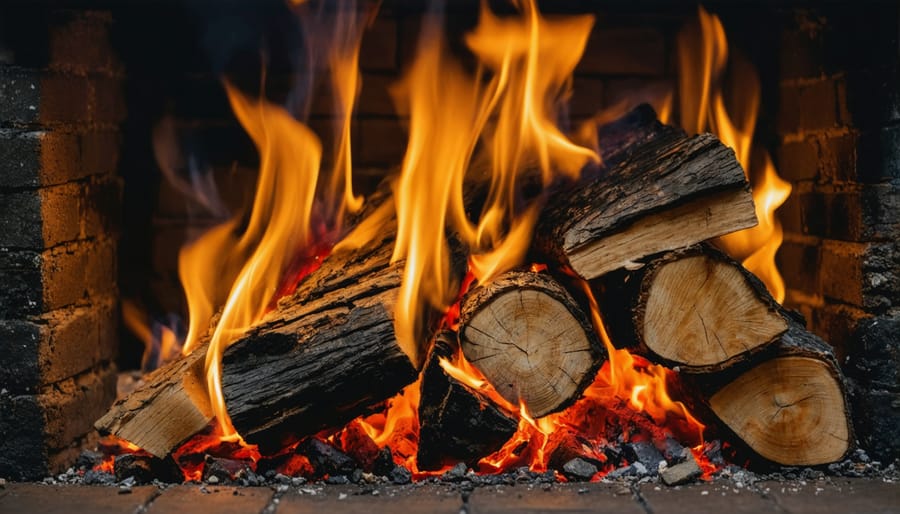
Proper Seasoning and Preparation
Properly preparing recycled wood is essential for creating an environmentally friendly fireplace experience that’s both safe and efficient. Think of seasoning wood like aging a fine wine—patience pays off beautifully.
First, ensure your recycled wood has a moisture content below 20%. You can check this with an inexpensive moisture meter from your local hardware store. Wood that’s too wet creates excessive smoke, reduces heat output, and leaves creosote buildup in your chimney—a recipe for poor performance and potential hazards.
Store your recycled wood in a dry, well-ventilated area for at least six months before burning. Stack it off the ground using pallets or lumber, and cover only the top to allow air circulation from the sides. This natural drying process transforms damp, inefficient fuel into clean-burning logs that produce more heat with less smoke.
Before tossing any piece into your fireplace, inspect it carefully. Remove any remaining nails, screws, or metal fasteners, and discard pieces with paint, varnish, or suspicious staining. Clean, properly seasoned recycled wood burns almost as well as virgin timber while giving new life to materials that might otherwise end up in landfills—a win for both your home’s ambiance and the environment.
Mixing Strategies for Better Burns
Getting the most from your fireplace while keeping emissions low comes down to smart mixing. Think of it like creating the perfect recipe – combining recycled wood with traditional hardwood in the right proportions can give you a cleaner, longer-lasting burn.
Start with a base of seasoned hardwood logs, which provide steady heat and a solid ember bed. Then add smaller pieces of untreated recycled wood – like clean pallet wood or reclaimed lumber – to supplement the fire. A good ratio is about 70% traditional firewood to 30% recycled wood. This balance ensures you’re making use of reclaimed materials while maintaining optimal burning temperatures.
The key is layering strategically. Place your seasoned hardwood on the bottom to establish strong coals, then add recycled pieces on top where they’ll burn hotter and more completely. This method reduces smoke and helps any potential contaminants break down more effectively.
Always keep your fires hot rather than letting them smolder – hotter burns mean fewer particulates released into the air. And remember, even with perfect mixing, proper ventilation and a clean chimney remain essential for both safety and efficiency in your eco-friendly heating journey.
Maximizing Heat While Minimizing Emissions
Getting the most heat from your recycled wood while keeping emissions low comes down to mastering a few simple burning techniques. Start by ensuring your wood is properly seasoned—moisture content should be below 20% for optimal combustion. Even recycled wood needs adequate drying time before it hits the flames.
Build smaller, hotter fires rather than large, smoldering ones. This “top-down” burning method, where you place kindling on top of larger logs, creates a cleaner burn with significantly less smoke. Keep air vents properly adjusted to maintain steady oxygen flow—too little air creates smoky, inefficient fires, while proper ventilation produces those beautiful, dancing flames with minimal environmental impact.
Consider investing in a fireplace insert or modern EPA-certified wood stove if you’re burning recycled wood regularly. These upgrades can boost efficiency by up to 50% compared to traditional open fireplaces, transforming your eco-friendly fuel into maximum warmth for your home while dramatically reducing particulate emissions into the atmosphere.
Better Alternatives: Truly Eco-Friendly Fireplace Fuels
Sustainably Sourced Firewood
When choosing firewood for your environmentally friendly fireplace, sourcing matters just as much as what you burn. Look for locally harvested wood from suppliers within 50 miles of your home—this reduces transportation emissions and supports your local economy. Even better, seek out FSC-certified (Forest Stewardship Council) or SFI-certified (Sustainable Forestry Initiative) firewood, which guarantees responsible forest management practices.
Local firewood also helps prevent the spread of invasive pests and diseases that can hitchhike across state lines in wood. Seasoned hardwoods like oak, maple, and ash burn cleaner and hotter than softwoods, producing less smoke and creosote buildup. Ask your supplier about their seasoning process—properly dried wood (below 20% moisture content) makes all the difference in efficiency and emissions.
While sustainably sourced firewood remains an excellent choice, don’t forget to explore alternative sustainable fuel options that might complement your heating strategy throughout the year.
Manufactured Fire Logs and Eco-Bricks
If you’re looking for a reliable, eco-friendly alternative to traditional firewood, manufactured fire logs and eco-bricks offer an excellent solution that’s both sustainable and surprisingly convenient. These compressed logs are crafted from clean sawdust and wood waste that would otherwise end up in landfills, transforming industrial byproducts into efficient heating sources.
What makes these products special is their consistency. Unlike regular firewood with varying moisture content, manufactured logs are engineered to burn cleanly and predictably. They produce significantly less smoke and creosote buildup than traditional wood, which means cleaner air for your home and less maintenance for your chimney. Many brands burn 80% cleaner than cordwood, making them a smart choice for both your fireplace and the environment.
Eco-bricks take this concept further by using recycled wood waste compressed into dense, uniform blocks. They’re easy to store, light with minimal effort, and provide steady, controlled heat output. While sustainable algae biofuel represents the cutting edge of fireplace technology, manufactured logs offer an accessible middle ground between traditional wood burning and advanced alternatives, perfect for homeowners seeking practical eco-friendly warmth.
Choosing recycled wood for your fireplace can absolutely be part of an environmentally conscious heating strategy—but only when approached with knowledge and care. The key takeaway is that not all recycled wood is created equal. While clean, untreated wood offers a genuinely sustainable option that reduces waste and provides cozy warmth, painted, treated, or contaminated wood poses serious risks to your family’s health and your home’s safety.
True environmental responsibility isn’t just about reducing waste; it’s about protecting the air you breathe and the planet we all share. By carefully selecting your fuel sources, learning to identify hazardous materials, and following proper burning practices, you can enjoy the ambiance and comfort of your fireplace without compromise. And if you’re looking to explore truly eco-friendly alternatives beyond traditional wood, there are innovative options worth considering.
The bottom line? Make informed choices. Your fireplace can be both a source of sustainable warmth and a safe, healthy addition to your home—when you prioritize doing it right.
